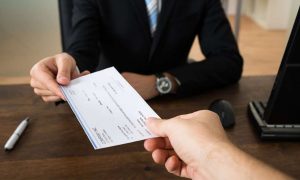When you need to make a large payment and a personal check or credit card isn’t acceptable, and paying with cash isn’t safe or practical, a cashier’s check is a sound option.
What is a cashier’s check?
Cashier’s check definition
A cashier’s check, also known as an official bank check, is a payment instrument issued by a bank or credit union to a third party, usually on behalf of a bank customer who pays the bank the face value of the check. In a major transaction, such as buying a boat or a home, a cashier’s check assures the payee that the funds are there because the check is backed by the bank’s funds, not the payer’s bank account, so the risk of the check bouncing is virtually nil.
The buyer of the cashier’s check pays the bank upfront for the full amount of the check. The bank deposits those funds and then issues the cashier’s check to the designated payee for the amount requested.
“When a bank issues a cashier’s check, the funds were already verified, as the customer purchasing the instrument must have good funds of their own available to fund the issuance of the check,” says Ben Craigie, director of compliance and training at the Massachusetts Bankers Association.
The check cannot be cashed by anyone but the designated payee and settlement is usually quicker than with a personal check.
When to use a cashier’s check
Some transactions will require a cashier’s check for payment. You might need a cashier’s check to make a security deposit on an apartment, for example, or to cover the down payment on a new car. Consumers often use cashier’s checks to pay a merchant or vendor that requires cash but will not accept personal checks. Cashier’s checks also are used in cash trades that must settle quickly, such as with real estate and brokerage transactions.
A merchant or payee who wants to avoid the risk of a counterfeit check or a check bouncing may require a cashier’s check for its security and guarantees.
“Cashier’s checks are one of the safest ways to make a bulk or large payment for transactions not involving electronic means,” Craigie says. “Cashier’s checks are still very useful for large down payments – possibly in real estate or car and other vehicle-sales transactions.”
How to get a cashier’s check
You will probably have to visit a bank branch or credit union to get a cashier’s check. Some banks will not issue cashier’s checks to non-customers.
To get a cashier’s check, be sure you have your personal identification with you, like a driver’s license. Have enough cash on hand or funds in your account to pay the bank the full amount of the check. You also must supply the name of the payee, since banks cannot issue blank cashier’s checks. Be sure to keep the receipt for the bank check.
Some online-only banks do provide cashier’s checks. Some traditional banks give you options of how to get a cashier’s check. Wells Fargo, for instance, allows its customers to order cashier’s checks in a branch or online. If you order a cashier’s check online, expect to pay a delivery fee.
Fees for a cashier’s check
Cashier’s checks cost in the neighborhood of $10-$15. Some banks waive the fee for certain account holders, so ask your bank. For example, Bank of America charges $15 for a cashier’s check, but waives the fee for account holders who meet certain balance requirements.
If you need to use cashier’s checks on a regular basis, you may want to find a bank that offers them for free with your account. Online banks such as Ally Bank and Discover, for example, offer free official bank checks.
If you order cashier’s checks online, either through an online-only bank or a traditional bank, the bank likely will charge you a delivery fee. Wells Fargo, for example, charges a $10 fee to issue a cashier’s check to its savings and checking account customers, plus an $8 delivery charge for online orders.
Are cashier’s checks safe?
Cashier’s checks are very safe because they are issued by a bank and are paid out of bank funds, not customer accounts. The bank fills in the “payable to” information and no one but the designated payee can cash the check.
Security is a big advantage of using a cashier’s check to make a payment. “It is a great way to carry a large amount of money without the risk of it being stolen,” says Robert Stammers, CFA, director of investor engagement at CFA Institute. “The checks can only be cashed by the intended recipient.”
Cashier’s checks also settle much faster than personal checks. “In many cases, the funds are available the next day,” Stammers says. Personal checks can take several days or longer to clear.
Craigie notes that security features such as watermarks are built into cashier’s checks to prevent or lower the risk of fraud.
If you lose a cashier’s check before you send it, don’t panic: You can get a replacement, but you will need to get an indemnity bond from an insurance broker for the amount of the lost check. The bond assures the bank that it will not be on the hook for two checks. Once you put the process into motion, it can take 30 to 90 days to get your replacement check.
Alternatives to cashier’s checks
If you are involved in a transaction of less than $1,000, a money order can be a good option for several reasons: They’re easier to get than cashier’s checks because they are sold at many grocery and convenience stores, the post office, Western Union and Walmart stores.
You don’t need a bank account to get a money order, and they’re much cheaper than cashier’s checks. And though they are not as secure as a bank check, they don’t bounce because the buyer must pay the vendor upfront for the full amount that is to be paid using the money order.
A certified check is another alternative. A certified check is a personal check that has been certified by the bank. The bank certifies that the funds for the amount the check is written for are, indeed, available and are earmarked for the designated payee. The bank also verifies that the payer’s signature is genuine.
Bottom line
A cashier’s check is a safe, efficient payment method when a large sum of money, generally anything over $1,000, is required.
The post Cashier’s checks: When to use one and how they work appeared first on Bankrate and is written by Libby Wells
Original source: Bankrate





